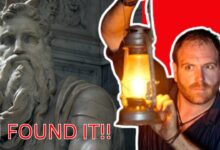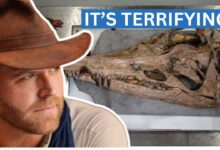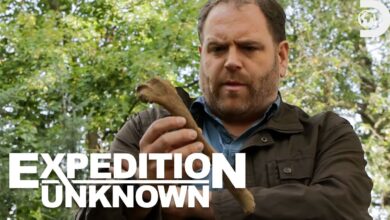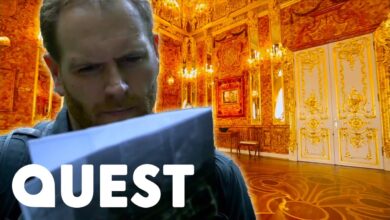Josh Gates Made A HORRIFING Discovery During Expedition Unknown
Josh Gates Made A HORRIFING Discovery During Expedition Unknown

My word, it is full of bones. Oh my God, this is a full skeleton—look at this!
From a trip to Spain to learn the truth behind this supposedly Celtic king who could be the founding father of the kingdom of Spain, to the search for an ancient African king that would defy thousands of years of legend, here’s how Josh Gates made a terrifying discovery on Expedition Unknown.
Amazing! Looks like JH Gates is at it again, back on the search for the truths behind many of the mysteries and legends that have been created by the human race ever since we became conscious of ourselves. And believe us, there are thousands upon thousands of these myths and legends.
Today, we’ll be following the American explorer and archaeologist as he takes on the legends concerning some of the most historical kings and monarchs that you might have never heard of before.
First off, we follow the TV presenter to Asturias—officially called the Principality of Asturias, an autonomous community in the northwestern region of Spain known for its vast greenery and lush climate. Asturias is part of “Green Spain” and is also known for being rich in Celtic history. This is important because the Celtic history is why Josh and the Expedition Unknown team made their way to this part of Green Spain.
This is like… not a household chopping item. No, it’s a weapon.
This is a weapon? Yes.
When is this from?
Around Po’s time.
This is because Josh and his team were in search of King Po, a legendary figure in Spanish history who has been likened to the famous King Arthur of Camelot. Apparently, this Hispano-Visigoth nobleman is believed to be the one who founded the Kingdom of Asturias all the way back in 718. Also known as Pelagius, this 8th-century nobleman is believed to be responsible for initiating the Reconquista, the Christian conquest that took the Iberian Peninsula back from the conquering Moors.
Following this, it is said that he was able to establish the Asturian monarchy, thereby making him the forefather of all Iberian monarchies that would spring forth going forward.
So, this is a great story. It’s an amazing story. It’s an underdog story. It’s heroic. But is any of it true? This would include famous monarchies such as the kings of Castile, the kings of León, and even the kings of Portugal on the other side of the Iberian Peninsula. As you can imagine, this made Po a rather interesting figure in the history of Spain.
That said, there is still much that is unknown about this legendary king, and as such, it makes sense for Josh and his team to hop on the case.
When they get off that plane to Asturias, they found themselves inside the Larma Cave complex, a paleoanthropological cave system that is noted for having one of the best-preserved floors from the Paleolithic era. Not only that, it is said to have more than 4,000 fossils within its ancient walls.
Regardless of the fact that it seemed to be home to some of the most fascinating remains in history, Josh and his team were still surprised by the presence of a complete set of skeletal remains that they found within this massive prehistoric cave complex. This may be the best place to find the truth behind King Po’s legend, and to be honest, where’s better to start than the skeletal remains that the team found before them?
That said, they had a bit of a difficult task before them because, within moments, they realized that they were indeed in the midst of a total of five skeletal remains in the cave complex. Fortunately, the archaeologist who came along with the team was able to help Josh and the others confirm that these remains could be traced back to the time of King Pelagius, who went about avenging his deceased father before establishing a kingdom for himself back in the 8th century.
“It’s full of bones… It’s what? It’s full of bones. Human bones.”
Soon, they realized that they were in a chamber that was actually within an acropolis. Perhaps this was because they also just realized that the bodies had been laid out in some sort of formal arrangement while being surrounded by some pieces of stalactites in a manner that suggested it was some sort of burial rite. Truly intriguing.
To Josh’s shock, he’d find that people had made the difficult journey down here to do what they needed to do at the time, with only the use of torches and ropes. How on earth were they even able to pull that off? They truly must have felt that they were wading into the pits of Hades. Nonetheless, it must have been worth it all because this was done to complete a burial rite, just as Josh and his team had established once they saw the bodies and the materials on the floor.
Josh was eager to learn more about the cave complex and what it meant to the people who performed these burial rites there, as well as look into other things beyond the bodily remains of the dearly departed. Soon, they found that there were other items, such as a metal belt buckle and a lead cross, which indicated that these people were Christians.
It was truly confusing because the arrangement of the bodies that they had just come across looked exactly like some of the pagan burial rites that they had encountered in their careers. After some deliberation, Josh and the team came to the conclusion that these people must have existed in a time when pagan rituals and Christian rites existed side by side in the community.
They were grateful for the fact that these bodies—and the relics found in the area—had been preserved excellently despite the fact that they had been down there for more than a thousand years.
Well, all except the skull. Despite still being there, something or someone had gone through the trouble of smashing the skulls of these bodies down to dust.
“How many of these skeletons are here?”
“There are five in this gallery.”
“Five… And these are from the time of Po?”
“Yeah.”
You may be wondering why, like any normal human being. Fascinatingly, the archaeologists were of the belief that these skulls were crushed because some people did not want these individuals to return to life.
Unbelievable, especially when one remembers the myths and legends concerning the undead throughout human history—think of all the bodies that were decapitated or staked through the hearts so that they could prevent the rise of a ghoulish vampire, craving blood after returning as a demonic phantom from the afterlife.
Thank God for modern-day science. As much as this may have been a necessary evil of some sort, we are left to wonder who these people were and why they were given such a gruesome funeral.
What we can say is that the presence of these bodies and their mutilated skulls tells us that King Pelagius and his cohorts weren’t the fully devout Christians that the pages of history may want us to believe.
Hopefully, some more research would help us know more about the truth concerning this legendary King of the Spanish.








